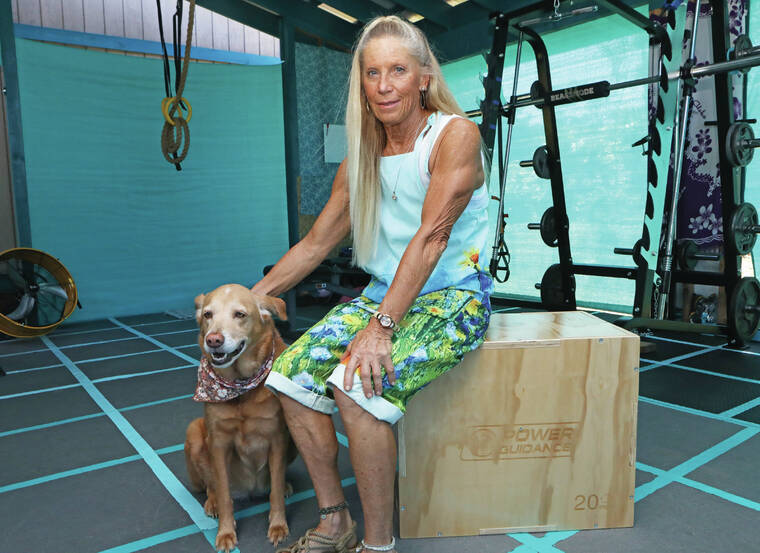Housing buyout program enables victims of 2018 Kilauea eruption to get on with their lives

Kelsey Walling/Tribune-Herald Kieba Blacklidge last week pets her dog, Austi, in her new home and gym in Hawaiian Beaches. Austi was rescued while Blacklidge was on the mainland during the 2018 lava flow and was the only thing recovered from Blacklidge's property.
Four years after her home and business were destroyed in the Kilauea eruption, Kieba Blacklidge has finally been able to move on.
Four years after her home and business were destroyed in the Kilauea eruption, Kieba Blacklidge has finally been able to move on.
Blacklidge, a personal trainer who used to run a fitness retreat at her home in Lanipuna Gardens, is one of 20 recipients so far of the county’s Voluntary Housing Buyout Program, which allows those whose properties were isolated, damaged or destroyed by the 2018 Kilauea eruption to have those properties bought by the county using federal funds.
ADVERTISING
“I think I was one of the first to apply,” Blacklidge said. “I decided to apply the day I knew about it.”
Blacklidge had been visiting the mainland when the eruption began in May 2018. As fissures opened throughout her neighborhood, she said she was unable to do anything to save the home where she lived for more than 14 years.
In the end, she said her housekeeper was able to save her dog but little else — not even her cat.
“I didn’t come back for months,” Blacklidge said. “Everyone told me not to bother, there was nothing left.”
Blacklidge estimated her property — which included a three-story home, two cabins, a gym, climbing walls and a studio — was probably worth more than $300,000. While she was able to get about $46,000 in aid from the Federal Emergency Management Agency, as well as a few extra thousand dollars from GoFundMe, Blacklidge said she had to borrow money from friends and family to build a new home and business on a property in Hawaiian Shores.
Consequently, she said that she leapt at the chance to have the county buy out her old property.
“Some people said I should keep it, since it now has this perfect view of the ocean,” Blacklidge said. “Fissure 22 is right under that property, they said I could open a rock quarry. But I’m 60 years old. I’m not opening a quarry.”
The buyout program allows owners of impacted primary or secondary homes to receive a payout based on assessed land values before the eruption, up to $230,000. Blacklidge said she wouldn’t have bothered with the program if she thought she would get less than $30,000 — she added that some prospective private buyers had contacted her about the land — but a county recovery worker told her that she would easily get more than that.
In the end, Blacklidge accepted a payout of $127,000.
“It’s definitely better than nothing,” she said, but added that, because several of the structures on the property were unpermitted, they didn’t count toward the assessed value of the land.
Blacklidge said the payout date was repeatedly delayed, with representatives of the program telling her it would probably happen by a particular date, only for that date to be pushed back over and over again.
Former Leilani Estates resident Kathy Urso said she had a similar experience. Also one of the first applicants for the program, she said she left her home with little more than the clothes she was wearing and her purse before it was wiped out during the first week of the eruption.
Urso said she immediately applied for the buyout program, but, similarly to Blacklidge, kept meeting delays.
“They were always asking more of me,” Urso said. “Every time they gave me a new date, they had something else I had to send in or resend. … They were very nice, but it kept getting pushed back.”
Eventually, Urso said, she complained directly to the county last month, and was informed shortly thereafter by an escrow agency that the transaction would finally be completed by Oct. 5.
She told the Tribune-Herald on Oct. 3 that she would be “shocked” if that deal actually came true, but confirmed on Friday that she did finally receive a payout from the program. She didn’t disclose the amount, but said it was the pre-eruption value of the home, minus the value of a U.S. Small Business Administration federal disaster loan she received following the disaster.
“Well, it took a year and a half, but I got it,” Urso said. “I don’t think I could have gone any longer without it.”
County disaster recovery communications specialist Jennifer Myers said via email that not only is the program first of its kind within the state, but each seller within the program also represents their own unique situation that can take time to navigate, with each application requiring more than 100 hours of work from county staff to move from submission to closing.
However, Myers added that with each round of payouts — Urso’s payout was part of a third batch of closings — the county is able to streamline the process further.
“We’re very proud that we’ll likely have more than 100 closings by the end of the year,” Myers wrote. By the end of September, there were 290 active applications from primary homeowners, 189 from secondary homeowners, and 137 from owners of undeveloped parcels.
Myers also added that, according to feedback from the U.S. Department of Housing and Urban Development, similar buyout programs throughout the nation have taken two years or more to reach their first closings.
In any case, Blacklidge said the payout has allowed her to get back to rebuilding her life. She said she used the money to pay back what she borrowed to build her new home and has resumed her personal training business in Hawaiian Shores.
“The whole thing has definitely made me a stronger person,” she said.
Email Michael Brestovansky at mbrestovansky@hawaiitribune-herald.com.


